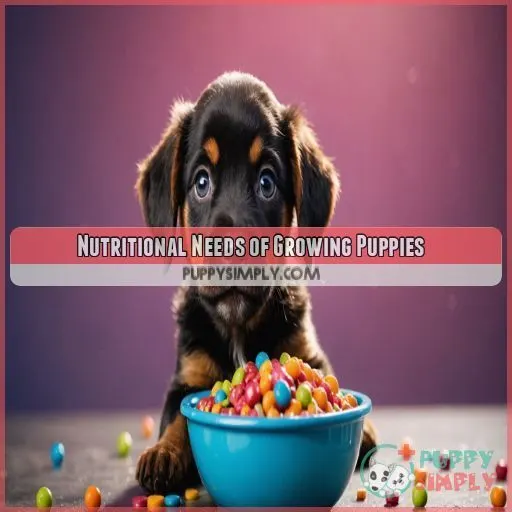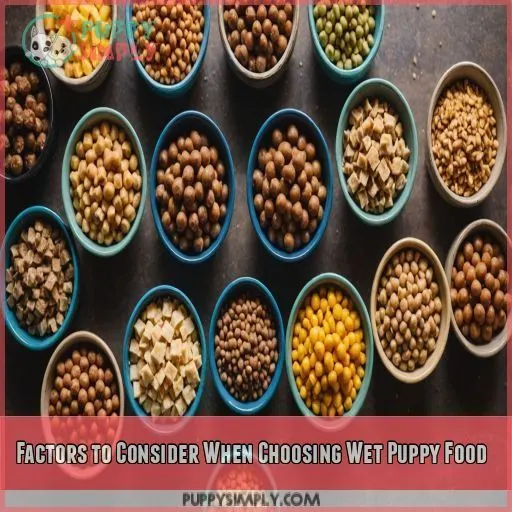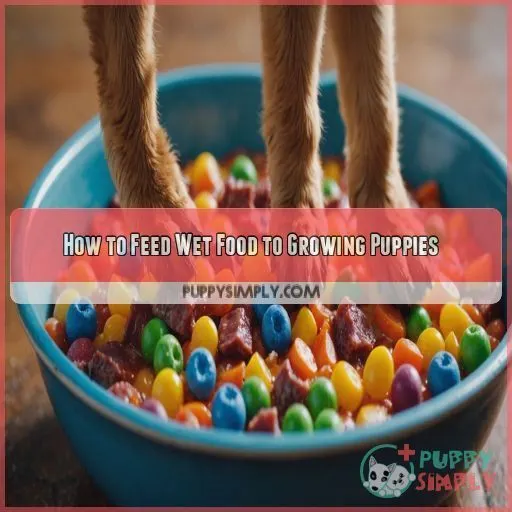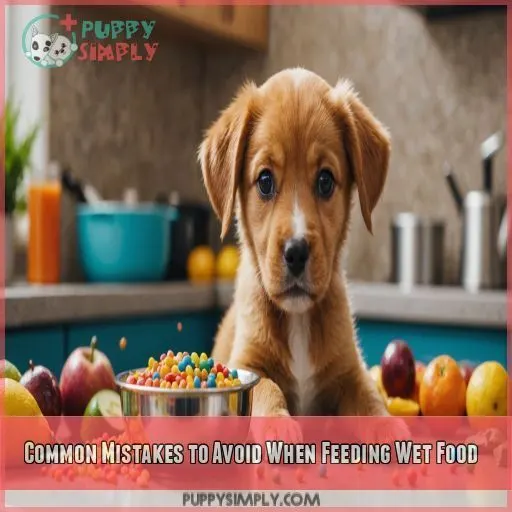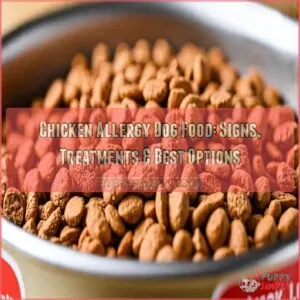This site is supported by our readers. We may earn a commission, at no cost to you, if you purchase through links.
 You’re wondering if wet food is the way to go for your growing puppy.
You’re wondering if wet food is the way to go for your growing puppy.
The short answer is yes! Wet food is a great choice, especially during the weaning process when your pup is moving from mom’s milk to solid food.
High-quality wet food provides the essential nutrients, like protein, calcium, and phosphorus, your pup needs for healthy growth and development.
Plus, it’s often more palatable and easier to digest than dry kibble.
But, with so many options out there, how do you choose the right one? Let’s break it down and explore the top picks for a healthy start.
Table Of Contents
- Key Takeaways
- Nutritional Needs of Growing Puppies
- Benefits of Wet Food for Growing Puppies
- 6 Best Wet Foods for Growing Puppies
- Factors to Consider When Choosing Wet Puppy Food
- How to Feed Wet Food to Growing Puppies
- Common Mistakes to Avoid When Feeding Wet Food
- Transitioning From Puppy Food to Adult Food
- Consulting With Your Veterinarian
- Frequently Asked Questions (FAQs)
- Conclusion
Key Takeaways
- You’re making a great choice by considering wet food for your growing puppy – it’s often more palatable and easier to digest than dry kibble, and it can provide the essential nutrients your pup needs for healthy growth and development.
- When choosing a wet food, look for high-quality protein sources like chicken or salmon, and ensure it’s formulated for your puppy’s life stage and breed size – your vet can help you navigate the options and create a customized nutrition plan.
- To avoid overfeeding or underfeeding, monitor your puppy’s weight gain and adjust their food portioning accordingly – a growth chart can be a helpful tool in tracking their progress and making adjustments as needed.
- Don’t forget to transition your puppy to adult food at the right time – usually between 9-12 months of age, depending on their breed and size – and do it gradually to prevent digestive upset, by mixing a small amount of adult food with their puppy food and increasing the proportion over 7-10 days.
Nutritional Needs of Growing Puppies
As you welcome a new furry friend into your family, understanding the nutritional needs of growing puppies is vital for giving them the best possible start in life. Providing your puppy with a well-balanced diet that meets their unique needs will help them grow into a strong, healthy, and happy adult dog, guaranteeing they receive the necessary care.
Importance of High-Quality Protein
As a puppy parent, you want the best for your furry friend.
High-quality protein is vital for muscle growth and development. Look for wet food with named protein sources like chicken, which provides essential amino acids.
A balanced nutrient profile supports superior protein digestibility, supporting healthy growth stages.
Your puppy will thank you for the extra attention to their protein needs!
Role of Calcium and Phosphorus in Bone Development
Now that we’ve covered the importance of high-quality protein, let’s talk about the dynamic duo of bone development: calcium and phosphorus! For your puppy’s bones to grow strong and healthy, these two minerals need to be in perfect harmony. Here are the key players:
- Calcium: helps build bone density and structure
- Phosphorus: supports bone mineralization and growth
- Balance: the ideal ratio of calcium to phosphorus for best bone development
Benefits of Antioxidants for a Healthy Immune System
Boosting your puppy’s immunity is a top priority.
Antioxidants play a starring role!
By incorporating antioxidant-rich foods like vitamins C and E, beta-carotene, and polyphenols into their wet food, you’ll help shield them from free radical damage.
Think of antioxidants like a superhero cape, protecting your puppy’s immune system and setting them up for a lifetime of health and happiness.
Benefits of Wet Food for Growing Puppies
You’re considering wet food for your growing puppy – a great choice! Wet food can offer numerous benefits, including better digestion, weight management, and a reduced risk of allergies, making it an excellent option for your furry friend’s healthy start in life.
Higher Moisture Content for Better Digestion
Feeding your puppy wet food can be a game-changer for their digestive health. With its higher moisture content, wet food helps prevent dehydration and promotes healthy stool quality. If your puppy is prone to digestion issues or diarrhea, a moist puppy food can be a lifesaver. Plus, it’s often more palatable than homemade meals or dry kibble.
Lower Carbohydrate Content for Weight Management
As you explore wet food options for your growing puppy, you’ll want to think about the benefits of lower carbohydrate content for weight management. By choosing a wet food with complex carbohydrates like sweet potatoes or brown rice, you can help your puppy maintain a healthy weight. This is especially important for large breeds prone to obesity.
More Palatable for Picky Eaters
Some puppies can be notoriously finicky eaters.
If you’ve got a picky pup on your hands, you’ll be relieved to know that wet food can be a total game-changer.
With its softer, more palatable texture, you can tempt even the most discerning eaters.
Try mixing it with dry food or using it as a meal topper to add some excitement to mealtime.
Reduced Risk of Allergies and Sensitivities
Enter the realm of reduced allergy risks for your growing pup!
By opting for wet food, you’re taking a proactive step in Food Allergy Prevention.
Hypoallergenic Diets rich in novel protein sources, like venison or salmon, can be a game-changer for sensitive skin care.
Plus, natural ingredients and no artificial flavors mean a lower risk of gluten intolerance and skin issues.
6 Best Wet Foods for Growing Puppies
You’re probably overwhelmed by the numerous wet food options for your growing puppy, but don’t worry, rest assured we’re here to help. Here are the top six wet foods that’ll give your furry friend the nutrients they need to thrive, from Royal Canin’s specially formulated puppy food to Blue Buffalo’s wholesome, grain-free options.
1. Royal Canin Puppy Canned Dog Food
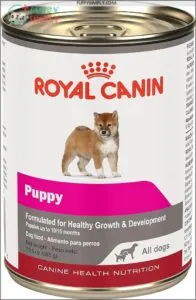
You’re looking for an exceptional wet food for your growing puppy! Royal Canin Puppy Canned Dog Food is an excellent choice. Formulated for healthy growth and development, it supports a developing immune system and digestive system. This highly palatable food is complete and balanced, making it perfect for puppies up to 10-15 months old. With its 100% satisfaction guarantee, you can trust that your furry friend is getting the best start in life.
Best For: Puppies up to 10-15 months old seeking a complete and balanced nutrition option for healthy growth and development .
- Highly palatable and supports healthy growth and development .
- Supports a developing immune system and digestive system .
- Backed by a 100% satisfaction guarantee .
- One customer reported receiving adult dog food instead of puppy food .
- Some ingredients, such as chicken by-products and corn meal, may be considered low-quality by some pet owners .
- May not be suitable for puppies with specific dietary needs or allergies .
2. Hills Science Diet Puppy Chicken Barley Loaf
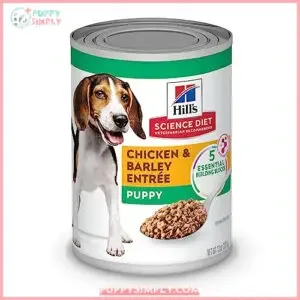
You’re considering Hills Science Diet Puppy Chicken Barley Loaf for your growing pup! This wet food is a great choice, made with DHA from fish oil for healthy brain and eye development. High-quality protein fuels growing muscles, while balanced minerals support growing bones and teeth. Made in the USA with global ingredients, this food is veterinarian-recommended. Just remember to follow the feeding guidelines, cover and refrigerate unused portions, and adjust as needed to maintain your pup’s proper weight.
Best For: This wet food is best for growing puppies who need a nutritious and balanced diet to support their development.
- Contains DHA for brain and eye development.
- High-quality protein for growing muscles.
- Veterinarian-recommended.
- May require adjusting feeding amounts to maintain proper weight.
- Contains fish oil, which some dogs may be allergic to.
- May need to be mixed with old food when transitioning to this new food.
3. Blue Buffalo Puppy Chicken Wet Dog Food
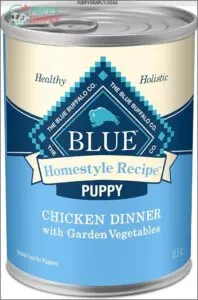
You’re considering Blue Buffalo Puppy Chicken Wet Dog Food for your growing pup! This recipe is made with real chicken, whole grains, fruits, and veggies, and is free from artificial flavors and preservatives. It’s also packed with DHA to support cognitive development. With its balanced nutrient profile and palatable texture, this food is perfect for picky eaters. Serve it as a complete meal, mix with dry food, or use as a tasty treat – the choice is yours!
Best For: Puppies who require a nutrient-rich, easily digestible, and palatable wet food to support their growth and development.
- Made with real chicken as the first ingredient, providing high-quality protein for muscle growth and development (Source).
- Contains DHA to support cognitive development and brain function .
- Free from artificial flavors and preservatives, making it a healthier option for puppies (Source).
- May be more expensive than other puppy food options, depending on the retailer and location .
- Some puppies may not tolerate the food well, especially if they have sensitive stomachs or food allergies (Source).
- The product size is limited to 12.5-oz cans, which may not be convenient for larger puppies or households with multiple puppies .
4. Purina Pro Plan Puppy Food
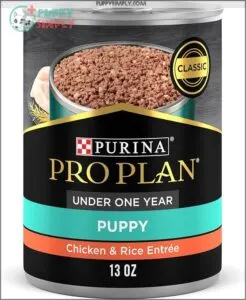
You’re considering Purina Pro Plan Puppy Food for your growing pup! This pate-style food is a great choice, offering high-quality protein from real chicken and 23 essential vitamins and minerals. With no artificial colors, flavors, or preservatives, you can trust you’re feeding your puppy a wholesome meal. Plus, it’s 100% complete and balanced nutrition for puppies up to 1 year old. Your puppy will love the taste and texture, and you’ll love the affordability and convenience .
Best For: Purina Pro Plan Puppy Food is best for owners looking for a complete and balanced pate-style food for their puppies up to one year old.
- High-quality protein from real chicken
- 23 essential vitamins and minerals
- No artificial colors, flavors, or preservatives
- May not be suitable for puppies with sensitive stomachs or allergies
- Some customers have reported diarrhea in their puppies
- May not be the best choice for picky eaters
5. Blue Buffalo Lamb Puppy Food Cups
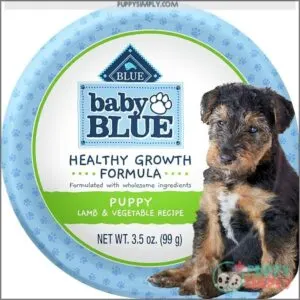
You’re considering Blue Buffalo Lamb Puppy Food Cups for your growing pup!
Made with real lamb as the first ingredient, these cups provide high-protein nutrition for cognitive development and energy .
With no chicken by-product meals, corn, wheat, or soy, you can trust the quality.
Follow the feeding guidelines:
- 3-4 feedings per day for puppies up to 11 weeks, and adjust as they grow.
A nutrient-rich, easily digestible option for a healthy start!
Best For: Puppies from weaning to maturity who require high-protein nutrition for cognitive development and energy .
- Made with real lamb as the first ingredient, providing high-protein nutrition for cognitive development and energy .
- No chicken by-product meals, corn, wheat, or soy, ensuring a high-quality and easily digestible option .
- Helps maintain a puppy’s energy level for play and adds variety to regular meals .
- Limited ingredients may not provide enough variety for some puppies .
- Some owners may find the feeding guidelines too general and require more specific instructions .
- The product may not be suitable for puppies with certain dietary restrictions or allergies .
6. Natural Puppy Food Chicken Salmon
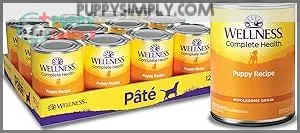
You’re looking for a natural, wholesome option for your growing puppy. Consider the Wellness Chicken & Salmon wet food. Made with real chicken and salmon, this food supports brain development and healthy bone growth. With no artificial colors or preservatives, you can feel good about what you’re feeding your pup. Some owners have reported a strong smell, but many puppies love it and thrive on it. Always consult with your vet before making any changes to your puppy’s diet.
Best For: This food is best for puppy owners looking for a natural, wholesome option with real chicken and salmon, supporting brain development and healthy bone growth.
- Made with real chicken and salmon
- Supports brain development and healthy bone growth
- No artificial colors or preservatives
- Some owners reported a strong smell
- One owner reported that their dog developed a bad smell on their skin after eating the food
- Some owners found the food to be expensive
Factors to Consider When Choosing Wet Puppy Food
When choosing a wet puppy food, you want to make sure you’re giving your furry friend the best possible start in life.
To do this, consider factors like your puppy’s breed size and nutritional needs.
You should also consider their age and life stage.
It’s important to look at the quality and sourcing of ingredients.
You should also consider the manufacturer’s reputation and expertise.
Breed Size and Nutritional Needs
As a puppy guardian, you should think about your furry friend’s breed size when choosing a wet puppy food. Small breeds, like toy and terrier breeds, need more calories per pound of body weight than large breeds. Look for puppy food formulas specifically designed for your breed size to make sure they grow and develop well.
Age and Life Stage
When you’re choosing wet puppy food, remember that your furry friend’s age and life stage play a significant role in their nutritional needs. Here are some key considerations:
- Puppies need more protein and calories than adult dogs.
- Divide your puppy’s daily ration into 3-4 meals until they’re six months old.
- Monitor their weight and adjust their food intake accordingly.
- Be prepared to switch to adult food between 9-12 months.
- Keep those puppy treats in check to avoid overfeeding!
Ingredient Quality and Sourcing
Now that you’ve considered your puppy’s age and life stage, let’s talk ingredients! You want the good stuff, sourced from trustworthy places. Look for transparent ingredient lists, adhering to AAFCO guidelines, with named animal protein sources (like chicken or salmon). Prioritize sustainability, animal welfare, and nutritional value. Your puppy’s health is worth it!
Manufacturer Reputation and Expertise
Now that you’ve got a handle on ingredient quality, let’s talk about the folks behind the food – the manufacturer. Look for brands that invest in research, conduct feeding trials, and have industry certifications. A reputable brand with a long history and a board-certified veterinary nutritionist on staff can give you peace of mind.
Label Claims and Certifications
Choosing wet puppy food can be tricky, so don’t just take the manufacturer’s word for it – check the label claims and certifications! Look for:
- AAFCO certification for nutritional balance
- Clear ingredient lists
- Veterinary nutritionist endorsements
- Feeding instructions for your puppy’s life stage
- Compliance with commercial dog food standards
This helps you get high-quality food that meets your puppy’s needs.
How to Feed Wet Food to Growing Puppies
You’re ready to give your growing puppy the best possible start with wet food, but you’re not sure where to begin. Let’s get down to business and explore how to feed wet food to your growing puppy, covering the essentials of feeding schedules, portions, and introducing new foods to make sure a healthy and happy pup.
Feeding Schedule and Portions
For the first six months, feed your puppy four times a day.
Then, gradually switch to three times a day until they’re a year old.
Portion sizes depend on breed and metabolism, so monitor your pup’s growth and adjust accordingly.
For large breeds, Royal Canin’s feeding chart is a great reference.
Mixing With Dry Food or Feeding Alone
Now that you’ve got a handle on feeding schedules and portions, let’s talk about mixing wet food with dry food or feeding it alone. Here are some options to think about:
- Wet food only: Great for picky eaters or those with sensitive stomachs.
- Dry food only: Convenient and cost-effective, but may not be as palatable.
- Mixed diet: Combines the benefits of both, with wet food adding moisture and flavor.
- Custom combinations: Work with your vet to create a mix specifically for your puppy’s needs.
Gradually Introducing New Foods
Introducing new foods to your pup? Do it gradually!
Mix a small amount of the new food with their current meal, and slowly increase the proportion over 7-10 days.
This helps prevent digestive upset and identifies potential food sensitivities.
As a pet parent, it’s your job to be patient and monitor for any adverse reactions, ensuring a smooth shift to the new food.
Monitoring Growth and Adjusting Feeding
As you feed your growing puppy, it’s important to monitor their growth and adjust their feeding schedule accordingly. After all, you want to make sure they’re getting the nutrients they need without overdoing it. Here are three things to keep in mind:
- Track your puppy’s weight gain using growth charts from the Pet Nutrition Alliance or World Small Animal Organization.
- Adjust portion control and feeding frequency to maintain a healthy body condition.
- Be aware of potential health conditions that may impact nutritional balance, such as food allergies or sensitivities.
Common Mistakes to Avoid When Feeding Wet Food
When you’re picking out wet food for your growing puppy, it’s important to avoid common mistakes that can hurt their health. By knowing what to watch out for, you can make sure your furry friend gets the nutrition they need to grow strong and avoid trips to the vet.
Overfeeding or Underfeeding
Don’t let your enthusiasm for feeding your puppy lead to overfeeding or underfeeding! Keeping an eye on their weight gain and adjusting food portioning is important. Consult a growth chart to make sure you’re on track. Avoid calorie counting stress by choosing a nutritionally balanced dog food. Check the table below for guidance on meal frequency and portion control.
| Puppy Age | Meal Frequency |
|---|---|
| 6-12 weeks | 4 meals/day |
| 3-6 months | 3 meals/day |
| 6-12 months | 2 meals/day |
| 1-2 years | 2 meals/day |
| Adult | 1-2 meals/day |
Not Providing Fresh Water
Now that we’ve covered overfeeding and underfeeding, let’s talk about another common mistake: not providing fresh water. Make sure your puppy’s water bowl is clean and filled daily. Dehydration symptoms include panting, drooling, and dark urine. Place the bowl near their food to encourage water intake. Use a water filter or change the water frequently to maintain quality.
Mixing With Table Scraps or People Food
Mixing table scraps or people food with your puppy’s wet food can be a recipe for disaster. Here are some reasons why:
- Human food dangers: common allergens like nuts, chocolate, and grapes
- Puppy health risks: pancreatitis, obesity, and nutritional imbalances
- Table scraps safety: bacterial contamination and food poisoning
- Homemade diet: inadequate nutrients for cognitive development
- Food allergies: introducing new foods too quickly can trigger reactions
Not Monitoring Growth and Health
Not monitoring your puppy’s growth and health can lead to issues like underfeeding or overfeeding.
Underfeeding or overfeeding can cause problems with heart health, kidney health, and joint development.
Regular vet visits and tracking your puppy’s weight gain on growth charts can help identify potential issues early on.
Stay on top of your puppy’s health to prevent costly medical conditions down the line.
Transitioning From Puppy Food to Adult Food
As your puppy grows into a strong and healthy adult dog, it’s important to switch to adult food at the right time to make sure they get the necessary nutrients for good health.
Typically, this change happens between 9 to 12 months of age.
However, the exact timing may vary depending on factors such as breed, size, and individual development.
Be sure to consult with your veterinarian for personalized guidance.
When to Switch to Adult Food
The big question: when to switch to adult food? It’s time to move to adult food when your puppy reaches 80-90% of their adult weight, usually between 9-12 months for small breeds and 12-18 months for larger breeds. Keep an eye on signs of maturity, like coat changes or decreased growth rate, and consult with your vet for personalized advice.
Gradual Transition to Prevent Digestive Upset
Switching from puppy food to adult food can be a delicate dance. To prevent digestive upset, mix a small amount of adult food with their puppy food, gradually increasing the proportion over 7-10 days. Monitor their stool quality and adjust as needed. This gentle change will help your furry friend’s tummy adjust to the new menu.
Choosing the Right Adult Food for Your Dog
As your puppy grows into adulthood, choosing the right food is really important. Here are some tips to help you make the right choice:
- Consider your dog’s breed, size, and activity level when selecting an adult food.
- Look for food with high-quality protein sources like chicken or fish.
- Check for added supplements like fish oil for skin and coat health.
- Consult with your vet to determine the best diet for your dog’s unique needs.
Consulting With Your Veterinarian
When you’re choosing wet food for your growing puppy, talking to your veterinarian is really important to make sure you’re picking the best options for their health and development. Your vet can give you personalized nutrition advice, help you keep an eye on your puppy’s growth and health, and deal with any food allergies or sensitivities that might come up.
Customized Nutrition Advice
When you’re figuring out puppy nutrition, remember that every pup is different. Your veterinarian can give you nutrition advice that’s perfect for your furry friend, taking into account potential food allergies, sensitivities, and dietary supplements. Don’t hesitate to ask about vet-recommended puppy food, homemade recipes, or supplements to make sure your pup gets the best possible start in life.
Monitoring Growth and Health
Now that you have customized nutrition advice, let’s talk about monitoring growth and health. To make sure your puppy is on track, follow these steps:
- Track their weight: Regular weigh-ins will help you catch any potential issues early.
- Celebrate milestones: Keep an eye on puppy milestones, like teething and vaccination schedules.
- Schedule regular vet checkups: Your vet will help you monitor growth and catch any potential health issues.
Addressing Food Allergies or Sensitivities
When your furry friend is feeling unwell, it’s a puzzle to solve. If you suspect a food allergy or sensitivity, consult with your veterinarian to identify common allergens and signs of sensitivity. They may recommend an elimination diet or holistic options to address the issue.
| Signs of Sensitivity | Common Allergens |
|---|---|
| Itching and scratching | Beef, dairy, wheat |
| Digestive issues | Chicken, eggs, soy |
| Skin irritations | Lamb, fish, corn |
| Ear infections | Gluten, artificial preservatives |
| Paw licking | Fillers, by-products |
Regular Check-Ups and Adjustments
Your vet is your partner in your puppy’s health journey. Schedule regular check-ups (every 2-3 months) to monitor their weight, track growth rate, and adjust their diet as needed. These frequent visits will also help you catch any food sensitivities or allergies early on, ensuring your furry friend stays happy and healthy.
Frequently Asked Questions (FAQs)
Can puppies eat wet food with sensitive stomachs safely?
You’re worried about your pup’s sensitive stomach. The good news is, many wet foods are designed to be gentle on tummies. Look for recipes with easy-to-digest ingredients, like chicken, rice, and sweet potatoes.
How often should I feed my puppy wet food daily?
Like a finely-tuned sports car, your puppy‘s engine needs regular fueling! Feed your puppy wet food 3-4 times a day until they’re six months old, then gradually switch to twice a day, adjusting portions as they grow.
What are the signs of overfeeding puppies with wet food?
You’re overfeeding your puppy if they’re gobbling up their wet food in seconds, their little belly’s looking more like a drum, or they’re skipping meals. Keep an eye on their weight and adjust those portions, pronto!
Can I mix different brands of wet food for puppies?
Did you know 75% of puppies are overfed? Mixing different brands of wet food can lead to nutrient imbalances. You can mix, but choose formulas with similar nutrient profiles and talk to your vet to make sure their diet is balanced.
How long can I store wet food in the refrigerator?
You can store wet food in the refrigerator for up to three to five days. Just make sure to keep it tightly sealed and at a consistent refrigerator temperature below 40°F (4°C) to prevent bacterial growth.
Conclusion
You’ve made it through the puppy food maze!
Choosing the right wet food for your growing puppy can be overwhelming.
Now you’re equipped with the top 6 picks for a healthy start.
By selecting the right wet food for growing puppies, you’ll set your furry friend up for a lifetime of health and happiness.
Your pup’s tail (and taste buds) will thank you!

